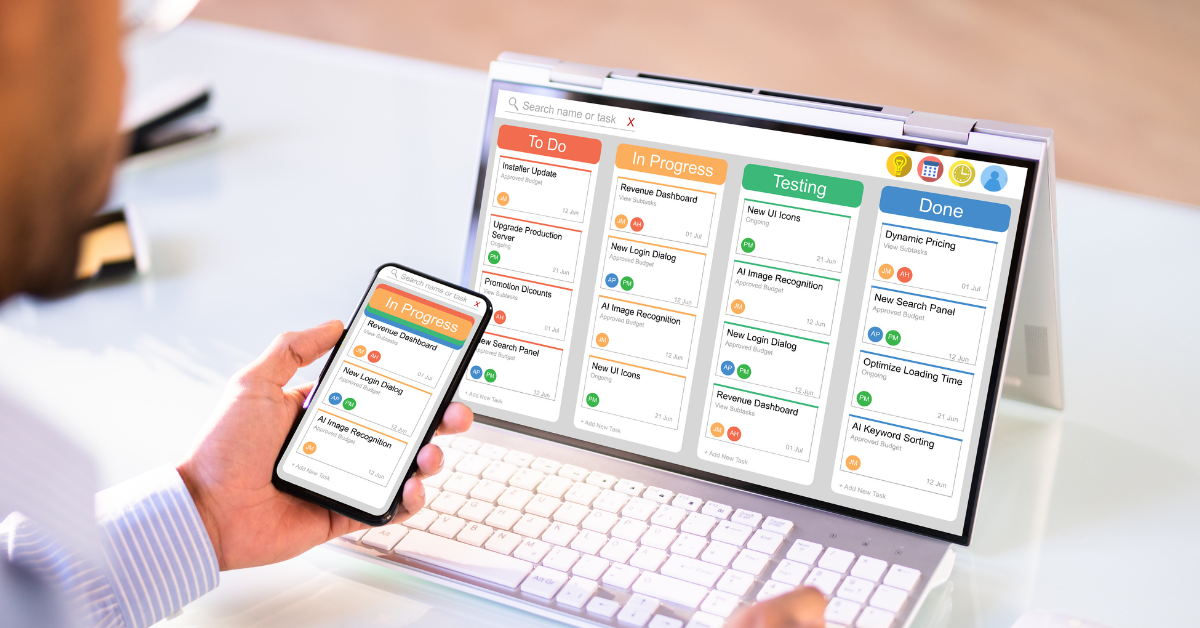The shift to remote work has brought exciting opportunities and difficult challenges for small business owners. While opening access to talent around the world, managing a dispersed workforce comes with its own headaches around communication, collaboration, and accountability. This is where implementing workflow management software (WMS) can make all the difference.
This blog provides small business owners with guidance on choosing the right workflow management software for their remote teams.
What is Workflow Management Software?

Workflow management software centralizes the tasks, processes, communication, and files involved in completing projects and running operations.
Key features include task management, file sharing, automated workflows, collaboration tools, and analytics reporting. WMS provides oversight into individual and team productivity through its systematic approach to managing each step and dependency within workflows.
Without the in-person visibility of on-site employees, many small business owners struggle to maintain productivity and alignment across their remote teams. Communication gets fractured across long email threads and isolated collaboration tools.
Accountability breaks down without direct oversight. Critical paths grind to a halt if the wrong person goes unexpectedly offline.
With the proliferation of WMS solutions now available, deciding which platform is the best fit can feel overwhelming. The goal is to match the right capabilities not just to the company’s needs, but also to the remote team’s workflows and preferred ways of working.
With the correct WMS implementation, small businesses can drive productivity, enhance teamwork, strengthen accountability, reduce costs, and power growth.
Benefits of WMS for Remote Teams
Effective workflow management is critical for small businesses with remote teams. Implementing WMS provides several key benefits:
Increased Productivity
WMS streamlines tasks and processes so team members can work more efficiently. Features like automated task routing, notifications, and process triggers eliminate bottlenecks and redundancy.
Team members can stay focused on core responsibilities with less administrative work. WMS also improves time management by tracking workloads, automating reminders, and ensuring clarity on priorities. Overall, WMS boosts productivity by optimizing how remote teams work.
Enhanced Collaboration
With WMS, remote teams collaborate in real-time on a centralized platform. File sharing, task management, and project dashboards provide visibility into workstreams.
Team members communicate efficiently through chat, comments, and notifications baked into workflows. WMS fosters connection and team spirit across locations. It also facilitates cross-functional collaboration with transparency into individual workloads and progress.
Improved Accountability and Transparency
Delegating tasks across a remote team raises accountability challenges. WMS brings structure through defined workflows, automatic hand-offs, and assigned responsibilities. Tasks have clear ownership with due dates and reminders.
Managers have visibility into workloads and track progress through automatic reports. All team members work collaboratively while remaining accountable individually. This clarity and transparency are difficult in manual systems.
Reduced Costs
WMS reduces costs associated with on-site staffing and paper-based processes. Streamlined workflows and automatic task handling lower administrative costs.
Features like e-signatures and document routing remove paper and manual work. By improving remote team efficiency, WMS requires less dedicated office resources. Automation and optimization powers substantial cost savings for small businesses.
Key WMS Considerations

When evaluating WMS options, focus on three key areas to ensure the platform aligns with your remote team’s needs:
Features and Functionality
The feature set and functionality should match critical business needs like task and project management, communication, file sharing, reporting, and desired integrations. Prioritize must-have capabilities like:
- Task management with assignments, status tracking, and reminders
- Real-time communication for team chat and notifications
- File sharing with cloud document storage and version history
- Project dashboards, reports, and analytics
- Integration with your existing software and tools
Avoid overpaying for unnecessary features. Focus on strengths that enhance productivity, collaboration, and transparency for your team.
Budget and Pricing
Compare pricing models like per user, per project, tiered plans based on features, etc. Many offer free trials or demo access, so test before committing. Budget for both current and future needs as your team grows.
Pay particular attention to:
- Free version limitations
- Monthly vs annual costs
- Number of user licenses needed
- Storage or bandwidth caps
- Premium add-ons or upgrades
Strike a balance between value and cost. Cheaper tools can end up costing more long-term in productivity, while expensive platforms may include unused features.
Ease of Use and Scalability
Evaluate both user experience and the platform’s ability to scale. Consider:
- How intuitive the interface is for different skill levels
- Availability of training resources and support
- Options to customize and configure workflows
- Ability to handle more users, projects, and activity over time
- Mobile optimization for remote access from anywhere
Prioritize platforms with the flexibility to adapt as your business evolves. An interface frustrating for non-technical users can hinder adoption.
Key Features to Look for in a WMS
When evaluating WMS options, there are several key features and functionalities to look for based on your team’s needs:
Task Management
- The ability to create, assign, and manage tasks and to-do lists.
- Set dependencies, due dates, reminders, priorities, and statuses.
- Get a bird’s-eye view of all tasks and projects.
Communication Tools
- Built-in messaging and chat functions for direct communication.
- Commenting capabilities on tasks and projects.
- Announcements and notifications to broadcast to the full team.
File Sharing
- Secure cloud storage to centralize files, documents, and project assets.
- Version history to track changes and prevent work loss.
- Restricted access and permissions to protect sensitive data.
Reporting and Analytics
- Dashboards and reports to view productivity metrics.
- Monitor task completion rates, backlogs, and cycle times.
- Identify bottlenecks and areas for process improvement.
Integrations
- Native, seamless integration with popular software like G Suite, Slack, Salesforce, etc.
- API access for custom integrations with proprietary apps and databases.
- Single sign-on for a unified user experience across tools.
Prioritize integrations and capabilities that will seamlessly connect workflows between your critical business systems. Choose a solution that aligns with your tech stack and provides the features your team needs to collaborate effectively.
Top 3 WMS Options for Small Businesses with Remote Teams

Option 1: Asana
Asana is one of the most popular workflow management systems, known for its intuitive interface and robust feature set.
Key strengths of Asana include:
- Visual task boards and project tracking
- File sharing and document management
- Powerful search and filtering capabilities
- Great for agile workflows and Kanban boards
- Hundreds of app integrations
Pros: Very user-friendly. Generous free plan. Interactive project views.
Cons: Can get pricey on paid tiers. Light on time tracking features.
Option 2: Trello
Trello takes a simple card-based approach to workflow management. Benefits of Trello:
- Simple and flexible Kanban boards
- Easy to get started and use
- Great for visualizing workflows
- Seamless team collaboration
- Affordable pricing tiers
Pros: Extremely intuitive and easy to use. Great free plan. Clean interface.
Cons: Limited features and customization. No built-in reporting. Can get messy with complexity.
Option 3: Airtable
Airtable combines spreadsheet-database flexibility with user-friendly interfaces. Key advantages include:
- Spreadsheet-like databases
- Customizable fields, views, and templates
- Intuitive cards and Kanban features
- Robust automation and integrations
- Scales from personal to enterprise use
Pros: Excellent no-code customization. Blocks and templates for common uses.
Cons: Steeper learning curve than Trello or Asana. Costlier pricing model.
Choosing the Best Fit
When choosing workflow management software for your small business, it’s important to keep the key considerations in mind and prioritize the essential features you need most.
First, reflect on the functionality that will serve your remote team best based on your business needs and processes. Focus on must-have capabilities like task management, collaboration tools, reporting, and automation features. Consider which integrations are crucial to connect the WMS with your existing systems.
Next, realistically weigh budget constraints. Opting for a more limited free version now doesn’t prohibit upgrading to more robust paid plans later as your needs grow. Take advantage of free trials to test different options thoroughly first.
Also, examine the user interface and ease of use, as adoption requires buy-in across employees with varied technical abilities. Look for platforms with intuitive navigation, quality mobile access, and the ability to scale seamlessly as your business expands.
If conducting a deeper analysis, consult product demos, user reviews, buyer’s guides, and experts. Comparing detailed pros and cons ensures you select the best solution tailored for your remote team’s success. With an informed decision, you can implement the optimal WMS with confidence.
Implementing WMS

Once you’ve chosen the right WMS for your team, the real work begins in rolling it out and driving adoption. A successful implementation requires planning, training, and optimization.
Onboarding and Setup
- Before launch, document all existing workflows, processes, and procedures to map into the new system. Identify what will change vs remain the same.
- Configure the platform for your workflows rather than changing processes to fit the software. Leverage built-in best practices while maintaining existing processes that work.
- Create a sandbox environment for testing before the official rollout. Identify power users to pilot the system and provide feedback.
User Training
- Develop customized onboarding materials including user guides, videos, FAQs, etc. Cater training to different learning styles.
- Schedule both live and self-paced training opportunities. Make training ongoing with refreshers.
- Incentivize participation by making training fun and valuable. Share success stories and adoption metrics.
Process Optimization
- Gather user feedback regularly via surveys, meetings, or built-in collaboration features. Identify pain points to improve.
- Analyze adoption metrics and workflows to optimize processes. Remove unnecessary steps or bottlenecks.
- Leverage reporting tools to identify issues and opportunities for improvement. Continuously refine over time.
With planning, training, and optimization, you can ensure a smooth implementation and drive maximum WMS adoption across your team. The upfront work will pay dividends in increased productivity, collaboration, and remote team connection.
Getting Team Buy-In
For a successful WMS implementation, it’s crucial to gain your team’s buy-in and enthusiasm. A top-down mandate rarely results in effective adoption – employees are more likely to embrace changes when they understand the benefits and are involved in the process.
Communicate Benefits
Explain how the WMS will make your team’s work lives easier, not harder. Highlight productivity gains, transparent communication, and features that address pain points. Convey your commitment to empowering employees with the right tools.
Involve The Team in Selection
Get input from employees on the features and functionality most important to their workflows. Consider a group demo to experience the top contenders together. The more say staff have, the more invested they’ll be.
Provide Training and Support
Don’t just turn on the system and expect users to figure it out. Offer onboarding resources like how-to guides, video tutorials, training sessions, and open office hours. Be available to answer usage questions. Foster an environment where it’s ok to learn the new system together.
With a focus on open communication, hands-on learning, and a shared vision of how the WMS benefits team productivity, you can foster excitement to use the new system.
An engaged, enthusiastic team is key for transforming workflows and how you collaborate across locations.
Driving WMS Adoption

Successfully rolling out a new workflow management system requires getting your team onboard and fully utilizing the platform. Here are some best practices for driving adoption:
Leader Use
Managers should actively use the WMS and champion its benefits. Leading by example is crucial. Share success stories of workflows improved through the WMS in team meetings. Publicize productivity or cost savings wins. Encourage cross-departmental collaboration through the WMS. Praise those who engage.
Ongoing Training
Don’t just do initial training. Offer refresher courses and quick tips at regular intervals. Maintain an FAQ doc, wiki, or forum for self-serve support materials. Set up office hours for quick questions. Have team super users provide mentorship.
Review Usage Analytics
- Use WMS reporting to review who is and isn’t using the platform. Reach out to under-utilizing teams.
- Gather user feedback on adoption blockers. Continuously refine the rollout plan.
- Show increased usage metrics over time. Celebrate milestones to maintain momentum.
Getting team buy-in is crucial for WMS’s success. Leaders should champion usage through their own engagement. Provide ongoing training and support channels to smooth the transition.
Analyze participation and respond accordingly. With a thoughtful adoption strategy, your team will fully embrace the WMS workflow revolution.
Conclusion
Implementing a workflow management system can provide immense value for small businesses with remote teams by increasing productivity, enhancing collaboration, improving transparency, and reducing costs. The key is choosing the right WMS that aligns with your business’s budget, needs, and goals.
Don’t let coordination challenges hold your business back. Take the first step and choose a WMS provider ready to partner with you for success. Your remote teams will gain their groove, your processes will be optimized, and your business will be fueled for the future. The opportunities are endless when your workforce is managed securely and effectively in the cloud.
Optimize your office efficiency now! Explore the best workflow management software with our expert virtual assistants here at Office Admin Help. Streamline tasks, enhance collaboration, and boost productivity.
Don’t miss out – choose the perfect fit for your team today!


